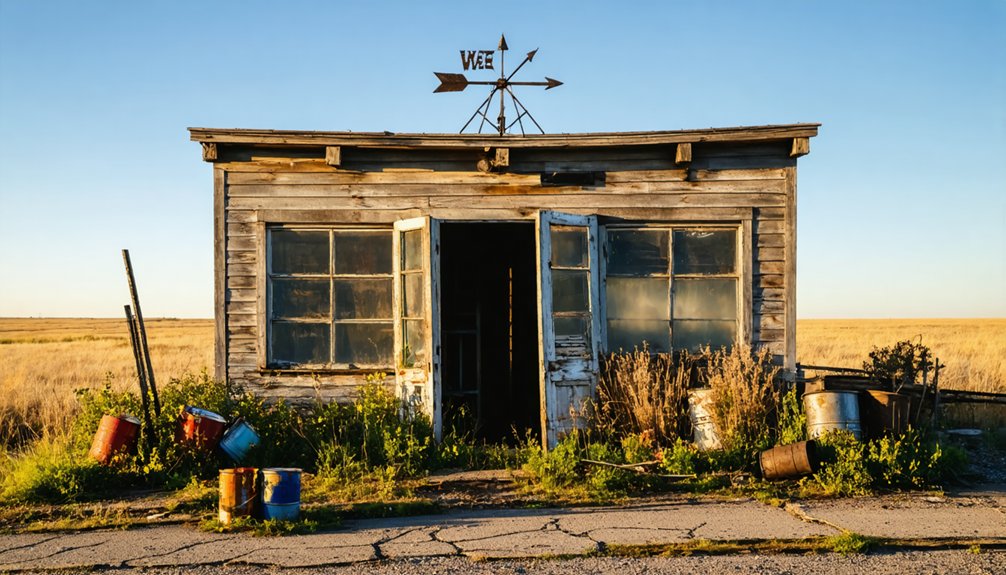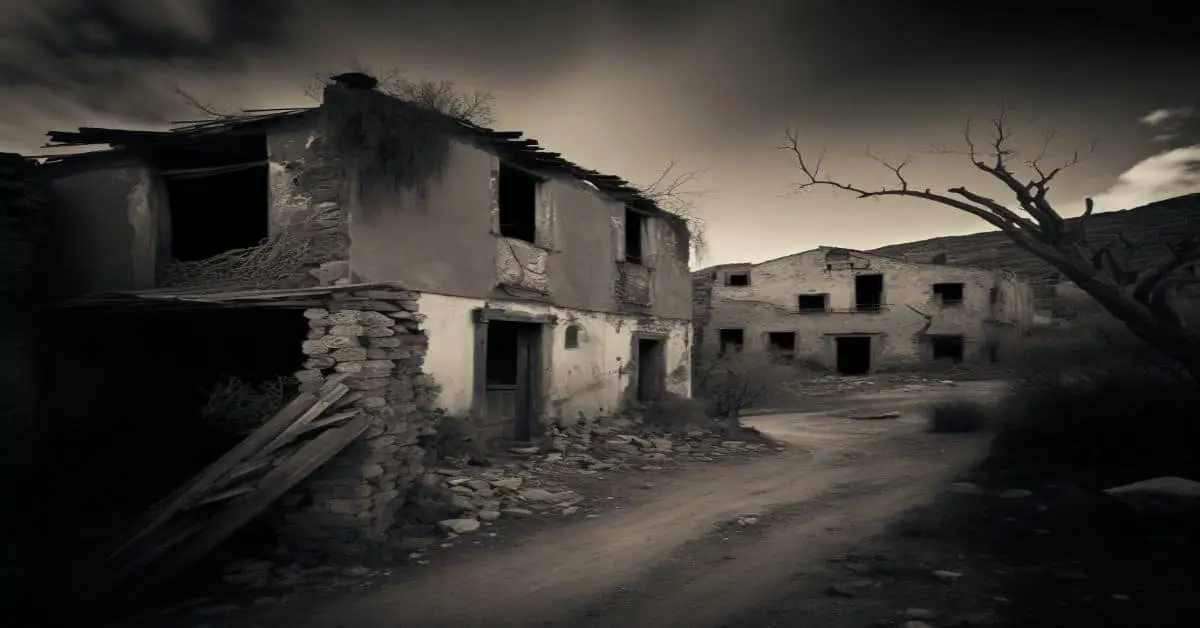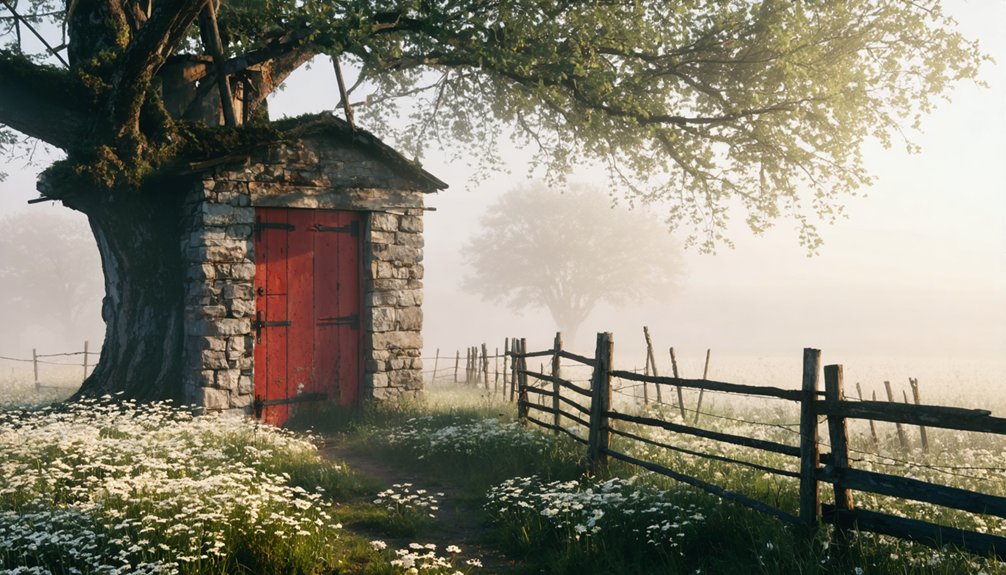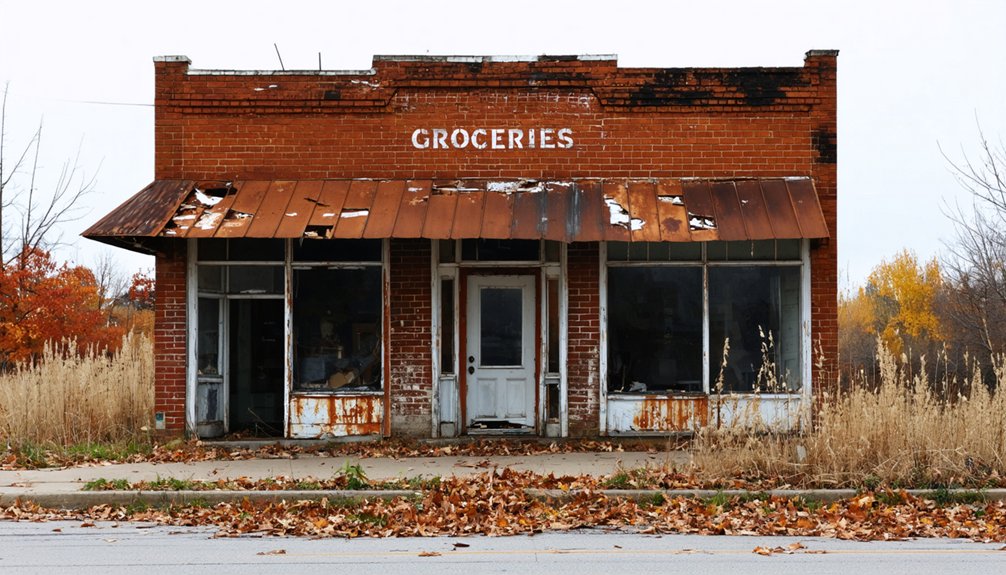You’ll find Ortonville’s ghostly remains in Iowa’s countryside, where Hiram Orton built the world’s largest wagon circus in the 1850s. This vibrant community once buzzed with trapeze artists and bareback riders during winter quarters, while serving as a bustling agricultural hub. The town’s fate shifted when railroad bypasses and farming changes forced residents to seek opportunities elsewhere. Today, no structures remain standing, but beneath the quiet fields lie stories of daredevils and dreams.
Key Takeaways
- Ortonville was established in the 1850s by Hiram Orton as a circus haven, becoming home to the world’s largest wagon circus.
- The town’s decline began when the railroad bypassed it, cutting off vital trade routes and leading to economic stagnation.
- Agricultural market shifts, mining industry collapse, and farm consolidation contributed to Ortonville’s eventual abandonment.
- The community thrived on circus traditions for four generations, with performers developing skills during winter quarters.
- Today, Ortonville has completely vanished, with no standing structures remaining and minimal historical documentation of its existence.
The Rise of a Circus Town
While countless towns sprouted across Iowa’s frontier in the mid-1800s, Ortonville emerged with a unique destiny as a circus haven.
You’ll find its circus heritage began when Hiram Orton, a pioneering circus director, purchased farmland east of Adel in the 1850s. He transformed this plot into winter quarters for his traveling show, establishing a legacy that would span four generations.
The town’s community traditions took root as circus performers, animal handlers, and support staff made Ortonville their seasonal home. Starting as a sailor on lakes, Orton found his true calling after watching a circus performance in Chicago that inspired him to create this unique community. The Orton family’s show grew to become the largest wagon circus in the world.
The town’s community traditions took root as circus performers, animal handlers, and support staff made Ortonville their seasonal home.
What started as a modest wagon show evolved into an impressive railroad operation by 1916, running at least 15 rail cars. Under Orton’s vision, the settlement grew into a self-sufficient hub where circus arts flourished and families passed down their performance skills through generations.
Historical Significance in Iowa’s Landscape
Before fading into Iowa’s ghostly past, Ortonville stood as a remarkable demonstration to rural development with its diverse array of essential services.
You’ll find its story woven into the fabric of Iowa’s landscape through grocery stores, telephone companies, and the unique cultural identity shaped by its circus heritage. The website features JavaScript requirements to ensure secure access and functionality.
What makes Ortonville extraordinary isn’t just its infrastructure – it’s the community resilience that enabled it to serve as both an agricultural hub and a winter home for celebrated circus performers.
Amos Orton established the settlement in 1839 after journeying from New York to build the first structures.
Today, you can explore this legacy through modern interpretive tools like mobile audio tours and scavenger hunts.
While the town’s physical presence has vanished, its significance endures as a reflection of Iowa’s rural evolution, showing how specialized communities adapted and thrived before succumbing to broader economic changes.
Economic Forces Behind the Decline
You’ll find that Ortonville’s decline began when the railroad bypassed the town, cutting off essential trade routes that once connected local farmers to broader markets.
Like many abandoned settlements, the town’s remaining infrastructure stands as a testament to its once-thriving community.
The transformation of agriculture from small family farms to large industrialized operations further weakened the town’s economic foundation as a rural service center.
When the region’s mining operations shut down, it dealt the final blow to Ortonville’s already fragile economy, leaving few employment options for remaining residents.
Residents were forced to seek better opportunities elsewhere as economic stagnation gripped the region, mirroring the challenges faced by towns like Mason City.
Railroad Impact on Trade
In the late 1800s, you’d have witnessed the town’s golden age when rail access connected local farmers and merchants to Chicago’s bustling markets. Fresh opportunities emerged as the rail network expanded, letting you ship grain and livestock faster than ever before.
But the town’s fortunes changed dramatically after 1900. As railroad companies merged and abandoned less profitable routes, you’d have seen Ortonville’s crucial trade connections slowly unravel. Today only 39% of tracks remain from Iowa’s peak rail infrastructure, showing how drastically the network has shrunk. The Department of Transportation’s rail abandonment records document the steady decline of service across Iowa’s regions.
The final blow came during the 1970s bankruptcies when major carriers like Milwaukee Road and Rock Island collapsed. Without rail service, you couldn’t compete with bigger cities anymore – shipping costs soared, businesses struggled, and your once-proud trading post began its descent into ghost town status.
Agricultural Market Shifts
While Ortonville’s railroad woes dealt the first blow, agricultural market shifts delivered the knockout punch to this once-thriving farming community.
You could trace the town’s decline to the brutal market fluctuations that followed World War I, when crop prices crashed and government price supports vanished overnight. Local farmers who’d expanded during wartime prosperity found themselves trapped in crushing debt.
As mechanization transformed farming, you’d see fewer but larger operations surviving the relentless pressure of agricultural policies and chronic oversupply. For every four failing farms, another local business shuttered its doors permanently.
When small farms failed, Ortonville’s businesses crumbled like dominoes – each farm foreclosure meant fewer customers at local stores and shops. The security verification process helped protect what remained of the town’s online historical records. The brutal economics forced families to abandon their dreams, leaving empty storefronts and quiet streets as silent reminders of a vanished way of life.
Mining Industry Collapse
As coal reserves beneath Ortonville’s rolling hills dwindled in the late 19th century, mine operators faced a stark reality that would seal the town’s fate.
You couldn’t escape the perfect storm that was brewing – depleted coal seams forced companies to seek richer deposits elsewhere, while advancing mining technology reduced the need for human labor.
The town’s lifeblood was further strained by fierce competition from other energy sources and larger mining operations in neighboring states.
Labor disputes between miners and company owners created additional tension, leading to work stoppages that crippled local economies.
When the mines finally shuttered, Ortonville’s lack of economic diversity left it particularly vulnerable.
Without the steady stream of coal industry jobs and income, the town’s businesses, schools, and community institutions began to crumble.
Life in Early Ortonville
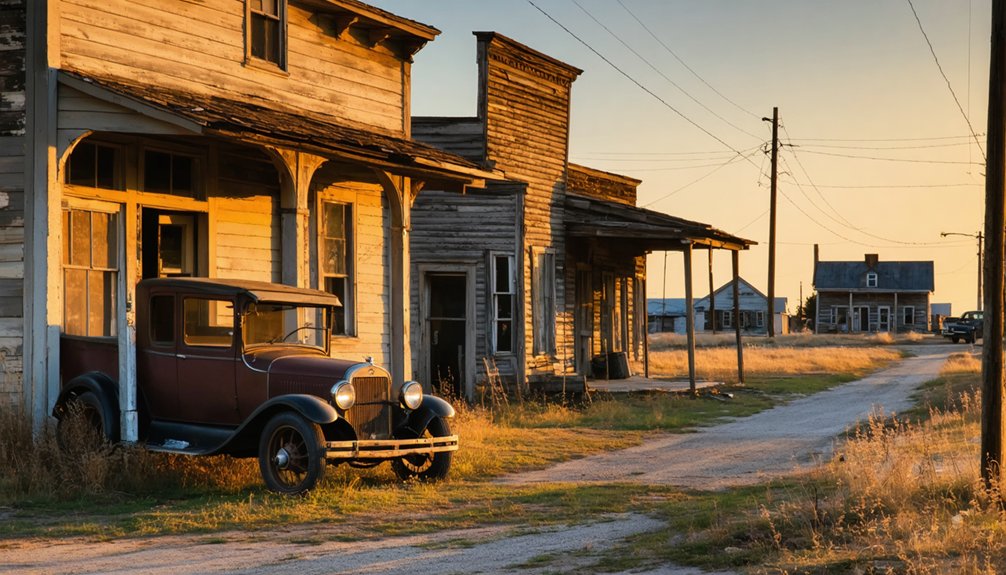
If you’d lived in early Ortonville, you’d have witnessed the seasonal bustle of Orton Circus performers preparing for shows and wintering in the small village.
The circus culture dominated local life, with the Orton family’s operation serving as the heartbeat of the modest community rather than the railroad activity common to other Iowa towns.
Though farming existed on a small scale, community gatherings centered primarily around circus-related events rather than traditional agricultural celebrations.
Daily Railroad Activity
Throughout the bustling days of early Ortonville, railroad activity pulsed like a heartbeat through the town’s core. You’d witness train schedules dictating the rhythm of daily life, with locomotives thundering through during peak morning and afternoon hours.
Rail maintenance crews worked tirelessly, ensuring every switch and track section remained primed for safe passage.
The station buzzed as freight trains hauled cattle from the stockyards and grain from the towering elevator. You’d find engineers, conductors, and brakemen coordinating their movements while telegraph operators clicked out messages across the lines.
Station agents managed the dance of incoming and outgoing traffic, their whistles piercing the air to signal arrivals and departures.
The railway’s presence meant freedom – connecting you to distant markets and far-off destinations.
Local Circus Culture
The roaring whistle of locomotives gave way to a different kind of spectacle in Ortonville – the magical world of circus performance. Under Hiram Orton’s vision, the town transformed into a vibrant hub of circus traditions, where four generations of performers honed their craft during winter quarters.
You’d have witnessed incredible feats as the Orton family pioneered daring acts, like bareback riders carrying children on their shoulders at full gallop.
From humble wagon shows to a mighty 15-car railroad circus, Ortonville’s performers brought entertainment across the heartland. The circus wasn’t just shows – it was the lifeblood of the community.
Performance arts thrived as families passed down their skills, while local businesses flourished supporting the circus through costume-making, horse care, and equipment maintenance.
Farm Community Gatherings
Beyond the dazzling circus performances, Ortonville’s heart beat strongest during its farm community gatherings. You’d find the spirit of freedom alive in the harvest celebrations that brought neighbors together across Iowa’s fertile fields.
These community traditions weren’t just social events – they were the lifeblood that kept Ortonville’s farming heritage pulsing through generations.
The gatherings reflected the rhythm of agricultural life:
- Planting festivals that marked spring’s promise of new beginnings
- Summer fairs showcasing the community’s finest livestock and crops
- Harvest celebrations with communal meals under open skies
- Winter gatherings where farmers shared stories and planned for the coming year
These events weren’t just celebrations – they were the threads that wove Ortonville’s social fabric, binding the community through shared agricultural triumphs and challenges.
Remnants and Structures Today
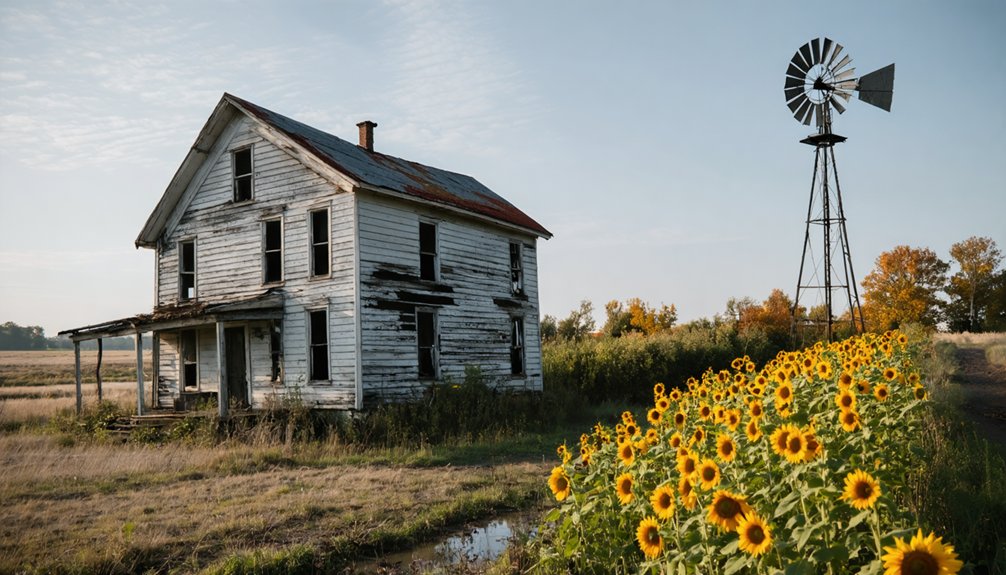
Unlike many historic ghost towns that retain visible ruins, modern-day Ortonville has virtually disappeared from Iowa’s landscape. You won’t find any standing structures or foundations marking this settlement’s disappearance – even the once-prominent service station along US Highway 6 has vanished due to road expansion.
Ortonville exemplifies the complete erasure of history, with no ruins remaining to mark where this Iowa settlement once existed.
Historical documentation remains scarce, with few photographs or maps surviving to tell Ortonville’s story.
While other Iowa ghost towns like Kinross and Dudley still showcase tangible remnants of their past, you’ll discover nothing but open land where Ortonville once stood.
No heritage markers guide visitors, and the site offers no designated areas for exploration. The village’s complete erasure stands as a reflection of time’s relentless march, leaving only memories where a community once thrived.
Impact of Railroad Development
Railroad development played a defining role in Ortonville’s brief existence and ultimate demise.
You’ll find that Iowa’s explosive rail growth from 655 miles in 1860 to over 10,500 miles by 1917 transformed the state’s economic landscape, but not all communities prospered equally from these iron pathways to prosperity.
- Your ancestors witnessed how railroad connections determined which towns would thrive and which would fade.
- You can trace Ortonville’s decline to its position away from major rail arteries.
- Economic migration drew residents toward better-connected regional hubs.
- You’d recognize how changing rail ownership patterns, especially after Rock Island’s 1975 bankruptcy, sealed the fate of marginal locations.
The town’s isolation from primary rail routes meant it couldn’t compete with communities that had direct access to the crucial transportation networks reshaping Iowa’s commercial geography.
Notable Stories and Legends
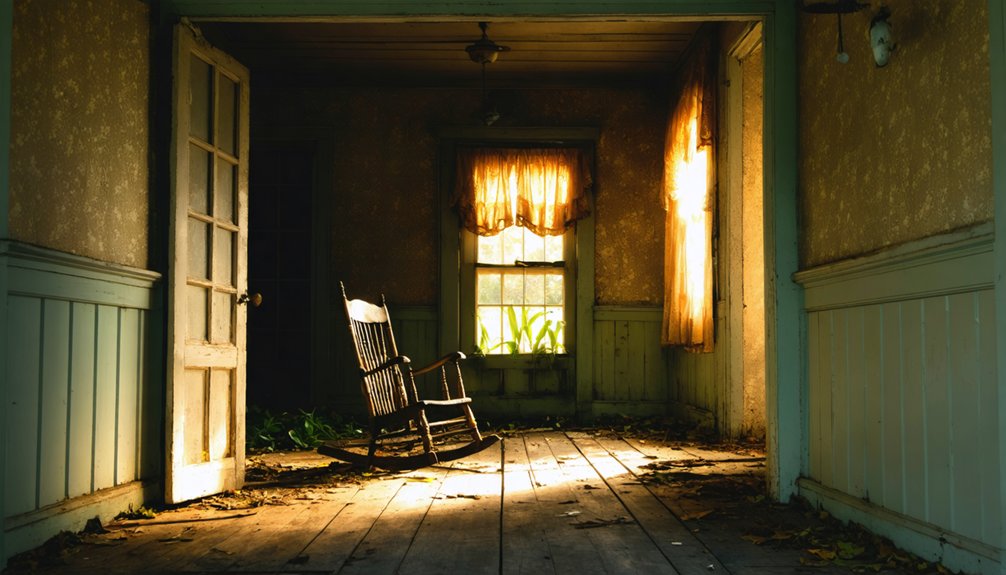
While many Iowa ghost towns fade quietly into history, Ortonville’s legacy lives on through its rich tapestry of supernatural tales and circus lore.
You’ll hear whispers of ghostly encounters along rural roads, where drivers face mysterious engine troubles and flickering headlights. The spirit of Miles Orton’s circus seems to linger, with phantom performers haunting the grounds where winter quarters once stood.
You might stumble upon abandoned farmhouses where unseen footsteps echo through empty halls, or feel an inexplicable cold presence watching you.
Local witnesses report shadowy figures in old-fashioned attire and circus spirits that appear at their bedsides. These stories interweave with broader Iowa haunting themes, yet Ortonville’s unique blend of circus heritage and ghostly phenomena sets it apart from typical ghost town tales.
Preserving Ortonville’s Legacy
Despite Ortonville’s physical disappearance from Iowa’s landscape, you’ll find its legacy preserved mainly through historical documentation rather than tangible remains.
The recent highway expansion erased the last visible landmark – the old service station – making digital storytelling and community engagement essential for keeping Ortonville’s memory alive.
- Local historians like Dave Baker continue sharing Ortonville’s story through educational presentations and websites.
- The town’s inclusion in ghost town lists helps preserve its place in Iowa’s settlement history.
- Digital archives and historical programs offer opportunities to document personal memories.
- Future generations can learn from Ortonville’s story through virtual preservation efforts.
While physical preservation isn’t possible, you can still contribute to Ortonville’s legacy by sharing family stories, photographs, or documents with local historical societies.
Frequently Asked Questions
What Was the Population of Ortonville During Its Peak Circus Years?
You won’t find exact Ortonville demographics during peak circus years, as records weren’t well-maintained. Your circus community likely included performers, workers, and locals, though population figures remain mysteriously elusive.
Are There Any Living Descendants of Original Ortonville Circus Performers?
You’ll need to do some digging, as descendant records aren’t readily available. While the circus heritage lives on, there’s no confirmed information about living performers’ descendants from the Orton family line.
What Specific Circus Acts or Shows Were Ortonville Most Famous For?
You’d recognize Miles Orton’s legendary bareback riding act where he carried his son on his shoulders while racing horses. Though clown performances and acrobatic feats occurred, equestrian shows defined Ortonville’s fame.
When Was the Last Documented Circus Performance Held in Ortonville?
You won’t find a precise date for Ortonville’s last circus performance in circus history records. While the Orton legacy lasted 66 years, the final show remains undocumented as the town faded away.
Did Any Famous Circus Performers or Personalities Originate From Ortonville?
Despite Ortonville’s rich circus history, you won’t find any nationally famous performers who originated there. The Orton family trained generations of circus artists, but none achieved widespread individual recognition beyond local fame.
References
- https://www.youtube.com/watch?v=tJv8JJupJhs
- https://freepages.rootsweb.com/~gtusa/history/usa/ia.htm
- https://jackandkitty.com/iowa-ghost-towns/
- https://freepages.rootsweb.com/~gtusa/history/usa/ia/gts.htm
- https://www.ghosttowns.com/states/ia/ia.html
- https://www.ghosttowns.com/states/ia/ortonville.html
- https://b100quadcities.com/six-ghost-towns-in-iowa/
- https://us1049quadcities.com/six-ghost-towns-in-iowa/?repeat=w3tc
- https://us1049quadcities.com/six-ghost-towns-in-iowa/
- https://www.elephant.se/person.php?id=1405
